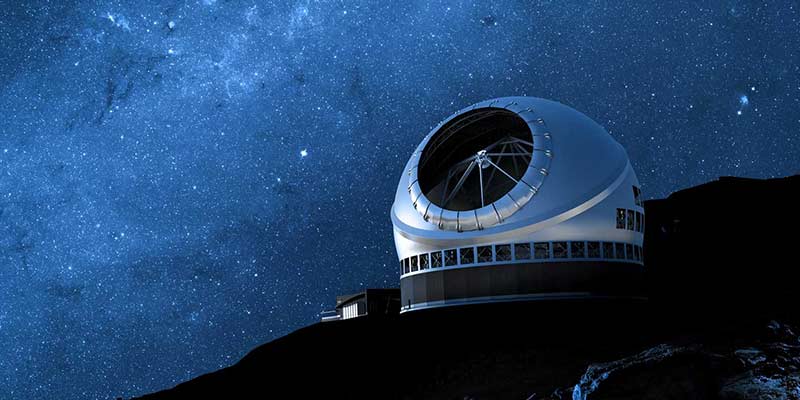- India
- Jul 10
Indian scientists develop infrared star catalogue for Thirty Meter Telescope
• A new online tool to create a comprehensive star catalogue for the Adaptive Optics (AO) system of the upcoming Thirty Meter Telescope (TMT).
• Telescopes on the surface of the Earth face the challenge of atmospheric distortion, affecting the quality of captured images. This is particularly crucial for telescopes with high light-collection capacities, like the TMT, which are sensitive to upper atmospheric disturbances.
• To counteract these distortions, the TMT will use an Adaptive Optics system that continuously senses and adjusts for atmospheric changes to produce high-quality images. In order to do this, an all-sky catalogue of Near Infrared stars is an essential requirement.
• The AOS system on TMT, known as the Narrow Field Infrared Adaptive Optics System (NFIRAOS), will be enhanced by a Laser Guide Star (LGS) facility.
• Researchers at the Indian Institute of Astrophysics (IIA) in Bengaluru and their collaborators have developed an automated code that can be used as an online tool to create a catalogue of Near Infrared stars.
• This facility will project up to nine lasers into the sky to create artificial guide stars. However, atmospheric turbulence affects these laser beams, so measuring atmospheric tip-tilt is uncertain. To correct these effects, the AO system requires feedback from three real stars, known as Natural Guide Stars (NGS).
Thirty Meter Telescope (TMT)
• The Thirty Meter Telescope (TMT) is a next-generation extremely large telescope that will offer astronomers a window to the Universe with unprecedented quality and depth.
• It is a 30-meter diameter primary mirror optical and infrared telescope being established at Mauna Kea in Hawaii.
• It is being designed and developed by the TMT International Observatory (TIO).
• The TMT will enable scientists to study fainter objects far away from us in the universe, which gives information about early stages of the evolution of the universe.
• It will also give finer details of not-so-far-away objects such as undiscovered planets and other objects in the solar system and planets around other stars.
• TMT’s light-collecting primary mirror will be the largest in the northern hemisphere.
• India is a founder-member partner in this project which aims to open new windows to the universe through optical and infrared astronomy.
• The TMT project is the joint responsibility of the Department of Science & Technology (DST) and the Department of Atomic Energy (DAE) from India.
• Hanle in Ladakh was one of the sites considered for hosting the telescope.
• The project is a non-profit collaboration among the University of California, the California Institute of Technology, the National Astronomical Observatories of the Chinese Academy of Sciences, the National Institutes of Natural Sciences of Japan, the National Research Council of Canada, and the Department of Science and Technology of India.
• India is a partner in the multi-billion dollar project which is expected to be completed in the early 2030s.
• The 30-meter primary mirror array is composed of 492 hexagonal segments, each 1.44 meters across. Its surface area will be larger than a standard baseball infield.
• The complex project involves making all the 492 segments to act as one single mirror of 30-m diameter while the telescope is tracking the sky with extreme precision.
• India’s contribution relates to the software, electronics and hardware to control the 492 segments behave as a single mirror within a few nanometers. More than a dozen industries are involved in making these very precision systems.
• TMT will have more light gathering power than the largest 10 existing ground-based telescopes combined, and its images will be 12 times sharper than those from the Hubble Space Telescope and more than four times sharper than those from the James Webb Space Telescope.
• The 50-meter-tall telescope weighs 2,650 tonnes and is enclosed within a very compact 56-meter tall dome.
Manorama Yearbook app is now available on Google Play Store and iOS App Store

